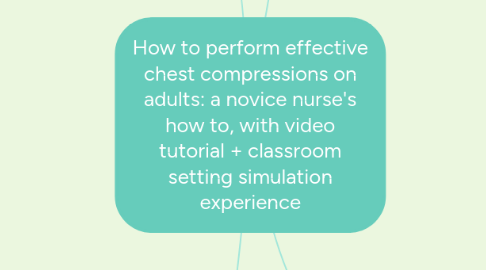
1. Criterion Referenced Instruction theory
1.1. Theorist
1.1.1. Robert Mager
1.2. View of Knowledge
1.2.1. based on ideas of mastery learning + performance-oriented instruction
1.2.1.1. 1. goal + task analysis
1.2.1.2. 2. performance objectives
1.2.1.3. 3. evaluation of learner
1.2.1.4. 4. material relevant to objective
1.3. View of Learner
1.3.1. learner initiated + self-management
1.4. Role of Student
1.4.1. learn at own pace, self exam to ensure mastery of material
1.5. Role of Educator
1.5.1. identify what needs to be learned, performance objectives, evaluation of learning skills, + development of simulation scenario for specific objectives
1.6. How theory addresses teaching scenario
1.6.1. Education will be based on learning specifically chest compressions, relevance and importance of proper technique in a situation where it would need to be used, case studies, utilizing video tutorial + active participation by the learner in simulation setting. debrief post simulation experience for self reflection.
2. Functional Context theory
2.1. Theorist
2.1.1. Tom Sticht
2.2. View of Knowledge
2.2.1. framework model of cognitive system emphasizes 3 components
2.2.1.1. 1. individual knowledge base
2.2.1.2. 2. process learner skills
2.2.1.3. 3. information provided reflects known knowledge
2.3. View of Learner
2.3.1. use of "real" materials in training will enhance learning when perform in real life scenario
2.4. Role of Student
2.4.1. information provided to make it relate to known knowledge and transform old information to new knowledge.
2.5. Role of Educator
2.5.1. stresses importance of making the learning relevant to current work
2.5.2. meaningful instruction + utilization of materials learner will use for future application
2.6. How theory addresses teaching scenario
2.6.1. In a simulation setting, new nursing grads will apply knowledge of cardiopulmonary function and use their tools (hands) to apply effective chest compressions. simulation set up like an inpatient setting, will have waveform capnography to assess performance - depth + rate. students able to experience how after 2 min. of performing skill, can become very tiring and may not be perform as effective - okay to ask to switch persons. role playing, skill building
3. Behavioral Learning Theory
3.1. Theorist
3.1.1. J. B. Watson + B. F. Skinner
3.2. View of Knowledge
3.2.1. all behavior is learned, changes to one's behavior are observable - practice + reinforcement to attain results. repetitive behavior is learned. association of stimulus to response
3.3. View of Learner
3.3.1. occurring through series of learning cues, practice + reinforce skill
3.4. Role of Student
3.4.1. video tutorial as a guide, watch, demonstrate + practice skill
3.5. Role of Educator
3.5.1. design a learning experience in a condition environment i.e. tutorial via video instruction, skills + simulation, offers positive reinforce, constructive criticism + feedback
3.6. How theory addresses teaching scenario
3.6.1. Theory applicable because it is a structured setting and step-step objectives observed + established quickly. Simulation learning environment facilitated by educator. educator will perform skill (chest compressions) to students, students will demonstrate behavior back to educator. motivation for student achievement through positive reinforcement. educator is able to observe student, correct their performance if needed, encourage student to interact, environment conducive to learner
4. Andragogy theory
4.1. Theorist
4.1.1. Malcolm Knowles
4.2. View of Knowledge
4.2.1. specific to adult learning - adults are self-directed + take responsibility for their decision-making
4.3. View of Learner
4.3.1. need to know why they need to learn, experiment, approach as problem-solving + if immediate value they learn best
4.4. Role of Student
4.4.1. their involvement in plan + self reflection and evaluation, learner must experience skills-apply, relate experience to how it will be utilized in practice
4.5. Role of Educator
4.5.1. act as a resource to learner versus a lecturer
4.6. How theory applies to teaching scenario
4.6.1. Must focus more on the specific skill, less on content + incorporate role playing, simulation scenarios. students will see the skill via video tutorial + instructor demonstration and then perform for the skill for evaluation of accuracy - hand placement, depth, rate. debriefing post simulation for self reflection and evaluation of learner
